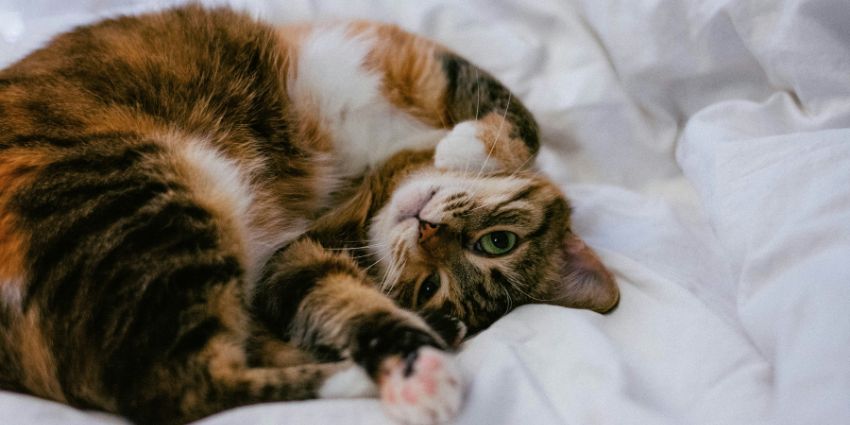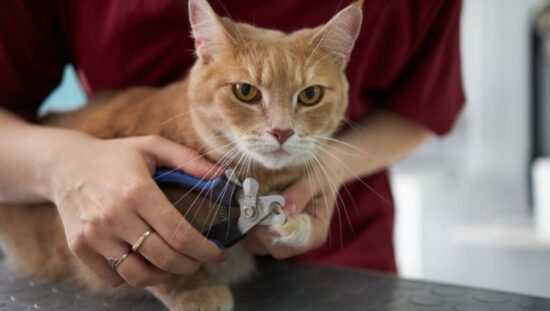Welcome to our guide on understanding cat language! Have you ever wondered what your cat is trying to tell you with its meows and gestures?
In this guide, we’ll learn about cat vocalizations, body language, and behavior. By learning these signals, you’ll deepen your bond with your feline friend.

The Basics of Cat Communication
Knowing how cats talk is crucial to getting close to them and keeping them happy. The way cats move their ears, tails, or faces tells us how they feel. Meows and purrs are also sounds cats make to express what they want or how they feel. In addition, they use their scent to mark their territory and communicate with each other. Cats use these signals to talk to us, so if we understand them, we can take better care of our cats and become better friends with them.
Decoding Cat Body Language
As we already mentioned, cats have their own special way of expressing themselves.
Watching how they move their tails, position their ears, and look at us can tell us a lot about how they’re feeling and what they want. Let’s look into these interesting clues to learn more about our furry friends:
1. Tail Signals
If a cat’s tail is held high, it usually means they’re feeling happy or confident. But if it’s low or tucked between their legs, that means they are probably scared or upset. If they flick their tails, it means they’re getting ready to play, or they’re annoyed. So, paying attention to how a cat’s tail moves can help us understand how they’re feeling.
2. Ear Movements
Cats also use their ears to show how they feel. When their ears are up, they’re curious or interested, but if their ears are flat, that means they might be upset. When they’re feeling relaxed and happy, their ears might be leaning back a bit.
3. Eye Contact
Cats talk with their eyes too! When they do a slow blink, it’s like saying “I trust you” or “I feel safe.” Big eyes with wide pupils might mean they’re excited or scared. And if a cat stares right at you without blinking, they could be saying “I’m focused” or “I want your attention.”
Understanding Vocalizations
Cats have a lot to say, and they use different sounds to communicate with us. Let’s explore the meanings behind their meows, purrs, hisses, and more. By understanding what these sounds mean, we can better understand how our cats are feeling and what they need from us.
I. Meows
Cats talk to us with their meows, and they have different meows for different things. A short, high-pitched meow is like saying “hello,” and a longer one might mean they want something, like attention or food. Some cats even have special meows just for certain things, like when they’re hungry or want to play. Sometimes, older cats or those not feeling well meow more to seek comfort.
II. Purrs, Hisses, and Growls
Purring often means they’re feeling cozy and content, like when they’re cuddled up with us or relaxing in their favorite spot. It’s their way of showing they’re happy and comfortable.
Hissing, on the other hand, is a warning sound. When a cat hisses, they’re telling us or another animal to stay away. It’s like they’re saying, “I’m scared” or “I’m feeling threatened,” and they want some space until they feel safe again.
Growling is similar to hissing but more serious. It’s a deeper, more intense sound that cats make when they’re really upset or angry. It’s their way of saying, “Back off.”
III. Chirps and Trills
Chirps and trills are special sounds that cats make, similar to bird noises. They use these sounds to talk to us or other cats.
These sounds often show happiness or excitement, like when they’re greeting us or playing. Sometimes, a mama cat will use chirps and trills to communicate with her kittens, like calling them to come eat or to follow her.
Behavioral Clues
From kneading to grooming, cats have their own unique ways of communicating with us. Let’s explore some common behavioral clues to understand our feline friends better.
I. Kneading
Cats knead with their paws by pushing in and out on soft surfaces, like blankets or your lap. We often say they “make biscuits”. They do this because it makes them feel cozy and happy, like when they were kittens nursing from their mom. Kneading also helps them relax and feel safe, so it’s a sign they’re feeling comfortable and content.
II. Rubbing and Head-Butting
When cats rub against people or objects and head-butt them gently, it’s like they’re leaving their scent behind to mark their territory and show they feel safe and secure. It’s their way of saying, “This is mine, and I trust you.” This behavior is also a sign of affection, showing that they like you and want to be close to you.
III. Grooming Habits
Cats like to keep themselves clean. They use their tongues to lick their fur, which helps remove dirt and loose hair. This grooming not only helps them stay clean but also regulates their body temperature and stimulates blood circulation.
They also like to groom each other as a way to bond and show affection. So, grooming is not just about staying clean for cats—it’s also about staying healthy and connected with their friends.
The Role of Scent in Cat Communication
Cats use their sense of smell to talk to each other and understand their world.
They have special scent glands on their cheeks, paws, and tail base. When they rub against things or other cats, they leave their scent behind, like putting their mark on something.
This scent marking tells other cats, “This is my place” or “I was here first.” It helps them know what areas belong to them and where they fit in with other cats. By exchanging scents through grooming or rubbing, cats also say, “We’re friends” or “We belong together.” This shared scent makes them feel comfortable and connected.
Additionally, cats use scent marking to show who’s in charge. The boss cats might mark their territory a lot to let everyone know they’re in charge. Other cats might not mark as much to avoid fights and show they know who’s boss.
Overall, scent marking serves as a form of communication for cats. It is how cats talk about their territory, friendships, and who’s in charge. By sniffing and leaving their scents, cats figure out who’s who and get along better with each other.
Improving Your Response to Cat Language
If you want to understand your cat’s language better, you need to pay close attention to how they act and what they’re trying to tell you. If your cat seems scared or wants some alone time, give them space to chill out.
But if they’re rubbing against you or purring, it’s a sign they want attention and love, so give them some pets and cuddles! Also, pay attention to where your cat likes to hang out and what toys they enjoy playing with, so you can create a cozy spot for them and spend time playing together, which helps strengthen your bond. And don’t forget about their scent! Cats leave their smell on things to mark their territory and feel safe. So, let them do their thing and explore their environment without getting upset.
Ready to make your feline friend purr with happiness? Dive into our blog Essential Cat Care Tips for Beginners for essential cat care tips perfect for beginners!
To Wrap Up
Understanding your cat’s language is like learning a secret code that helps you connect with them on a deeper level. By paying attention to their movements, sounds, and scent, you can decode what they’re trying to tell you and respond in a way that makes them feel loved and understood.
Building this bond with your cat not only strengthens your relationship but also creates a happier and more harmonious home for both of you. So, keep listening, observing, and responding with care, and enjoy the special connection you share with your furry friend.



